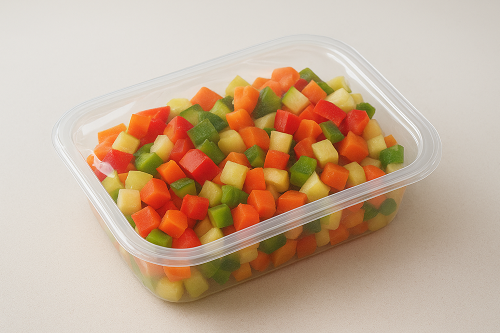In the modern food industry, packaging plays a critical role in maintaining product quality, extending shelf life, and providing convenience for both manufacturers and consumers. Lidding film food packaging has emerged as an essential solution, offering superior protection and versatility for a wide range of food products.
Product Functions and Uses
Lidding film is primarily used to seal containers such as trays, cups, or tubs, creating an airtight barrier that preserves the freshness and taste of the food inside. This type of packaging is especially suitable for perishable items such as ready-to-eat meals, dairy products, fruits, vegetables, and baked goods. By preventing exposure to air, moisture, and contaminants, lidding films significantly extend shelf life and maintain food safety. some lidding films are designed to be peelable, re-sealable, or microwave-safe, adding convenience for consumers.
Product Features
- High Barrier Performance: Lidding films are engineered to resist oxygen, moisture, and UV light, ensuring the food remains fresh and flavorful for longer periods.
- Durability and Strength: These films are tear-resistant, puncture-resistant, and able to withstand mechanical stress during transportation and handling.
- Temperature Resistance: Many lidding films can endure high temperatures, making them suitable for hot-fill processes, microwave heating, or sterilization procedures.
- Transparency and Printing Capability: Clear films allow consumers to see the product inside, while printable surfaces enable attractive branding and product information.
- Eco-Friendly Options: Modern lidding films include recyclable and biodegradable materials, aligning with sustainability goals and reducing environmental impact.
Product Specifications
- Material: PET, PE, PP, aluminum foil, or multilayer laminates.
- Thickness: Typically ranges from 20µm to 80µm depending on application.
- Dimensions: Customizable to fit trays, tubs, or cups of various sizes.
- Sealing Method: Heat-sealable, peelable, or adhesive-based.
- Barrier Levels: Oxygen transmission rate (OTR) and water vapor transmission rate (WVTR) can be tailored for specific food requirements.
Product Instructions
- Storage: Keep in a cool, dry place away from direct sunlight to maintain film integrity.
- Application: Apply lidding film to the container using compatible sealing machines, ensuring full adhesion for an airtight seal.
- Usage: For peelable films, instruct consumers to remove the lid carefully to avoid spillage. Microwave-safe films should be vented before heating.
- Disposal: Follow local recycling guidelines for recyclable or biodegradable films.
Applicable Industries
Lidding film food packaging is widely used in the following industries:
- Food Processing: Ready-to-eat meals, frozen foods, dairy, and desserts.
- Beverage Industry: Yogurt cups, juice containers, and smoothies.
- Catering and Retail: Packaged salads, sandwiches, and bakery items.
- Pharmaceutical and Nutraceutical: Some lidding films are also used for health supplements and medical food products.
Target Customer Groups
- Food manufacturers and processors seeking high-quality packaging solutions.
- Supermarkets and convenience stores needing ready-to-sell, attractive, and safe packaged products.
- Catering services and meal delivery companies requiring hygienic, easy-to-use packaging.
- Eco-conscious brands looking for sustainable, recyclable packaging options.
Lidding film food packaging represents a perfect combination of protection, functionality, and consumer convenience. With its diverse features, applications, and customization options, it continues to be a vital choice for businesses aiming to maintain product quality while enhancing brand appeal.


